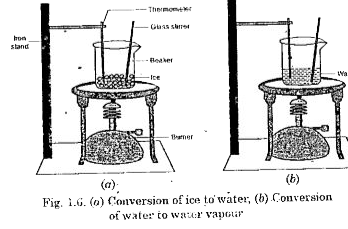Take about 150 g of ice in a beaker and suspend a laboratory thermometer so that it bulb is in contact with the ice, as in Fig.
Start heating the beaker on a low flame.
Note the temperature when the ice start melting.
Recod your observations for this conversion of solid to liquid state.
Now put a glass rod in the beaker and head while stirring till the water starts boiling. Keep a careful eye on the thermometer reading till most of the water has vaporised.
Record your observations for the conversion of water in the liquid state to the gaseous state.
What conclusion can you draw ?

Text Solution
(i) Ice will start melting at 0∘C (273.16 K).
(ii) When all the ice converts into water the temperature still remains 0∘C (273.16 K).
(iii) When liquid water is heated, its temperature gradually increases until it starts boiling. Water boils at 100°C under normal pressure:
(iv) After the liquid water has started boiling (at 100∘C ), its temperature becomes constant at 100∘C even when heating is continued. The temperature remains constant until the whole of water gets vapourised.
(v) We can conclude that the temperature remains constant during change of state.
|
Topper's Solved these Questions
- MATTER IN OUR SURROUNDINGS BOOK - NAND LAL PUBLICATIONCHAPTER - MATTER IN OUR SURROUNDINGS EXERCISE - ACTIVITY 1.13
1 Videos
- MATTER IN OUR SURROUNDINGS BOOK - NAND LAL PUBLICATIONCHAPTER - MATTER IN OUR SURROUNDINGS EXERCISE - ACTIVITY 1.14
4 Videos
- MATTER IN OUR SURROUNDINGS BOOK - NAND LAL PUBLICATIONCHAPTER - MATTER IN OUR SURROUNDINGS EXERCISE - ACTIVITY 1.11
2 Videos
- ATOMS AND MOLECULES BOOK - NAND LAL PUBLICATIONCHAPTER - ATOMS AND MOLECULES EXERCISE - ADDITIONAL QUESTIONS (LONG ANSWER TYPE QUESTIONS)
1 Videos
- STRUCTURE OF THE ATOM BOOK - NAND LAL PUBLICATIONCHAPTER - STRUCTURE OF THE ATOM EXERCISE - ADDITIONAL QUESTIONS (LONG ANSWER TYPE QUESTIONS )
1 Videos
Similar Questions
Continue heating even after ice starts melting.
View SolutionContinue heating even after ice starts melting.
View SolutionThe value of absolute temperature at which ice starts melting is
View SolutionThe value of absolute temperature at which ice starts melting is
View SolutionThe entropy change can be calculated by using the expression ΔS−qrevT. When water freezes in a glass beaker, choose the correct statement amongst the following:
View SolutionTake a few pieces of ice in a glass beaker.
View SolutionWhen an ice is kept on the palm, it starts melting because.
View SolutionWhen an ice is kept on the palm, it starts melting because.
View SolutionAs the ice is heated, it starts melting. Stir the mixture of ice and water.
View SolutionAs the ice is heated, it starts melting. Stir the mixture of ice and water.
View Solution
